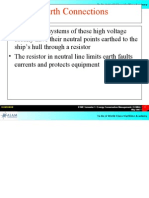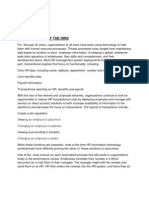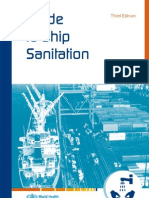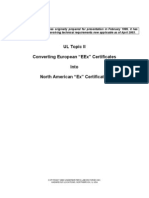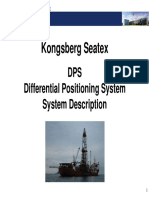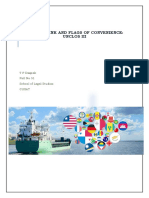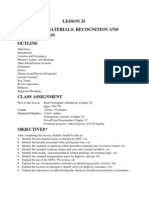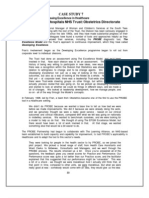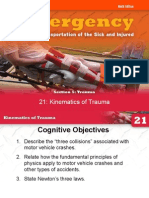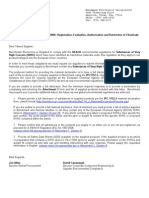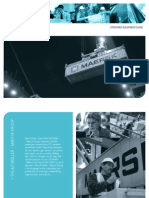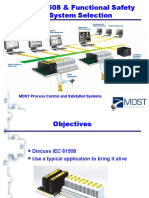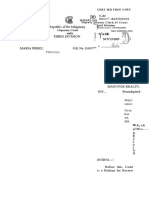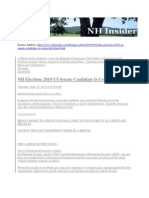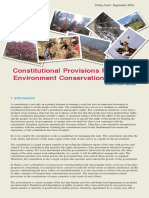About REACH - PDF
About REACH - PDF
Uploaded by
Tri-Sure More Than ClosuresCopyright:
Available Formats
About REACH - PDF
About REACH - PDF
Uploaded by
Tri-Sure More Than ClosuresOriginal Title
Copyright
Available Formats
Share this document
Did you find this document useful?
Is this content inappropriate?
Copyright:
Available Formats
About REACH - PDF
About REACH - PDF
Uploaded by
Tri-Sure More Than ClosuresCopyright:
Available Formats
REACH - The Basics
If you have responsibilities under REACH then you need to know what
impact this might have on your business. This leaflet summarises the
different elements of REACH which may affect your business.
What is REACH?
REACH (Registration, Evaluation, Authorisation and restriction of Chemicals) is the system for controlling
st
chemicals in the EU. It became law in the UK on 1 June 2007.
Because any company could be affected by REACH, it is important that they understand what REACH
requires and their duties under the legislation. Identifying where your company fits into the supply chain is
important as this will determine what you have to do and when you have to do it – not all requirements of
REACH apply immediately. Below are summarised the key stages in the process.
Registration
Any company manufacturing or importing into the EU a substance on its own, in a preparation (mixture of
substances), or intentionally released from articles (finished manufactured goods) at or above 1 tonne
per year may have to register it. This is done by submitting a dossier to the European Chemicals Agency
(the Agency; ECHA), based in Helsinki. The dossier contains details of the substance’s properties, other
relevant information about risks and how these risks can be managed. You will not be able to
manufacture or import a substance within the EU, or import an article that intentionally releases a
substance, unless the substance has been registered.
To ease the move to the REACH provisions, registration will be ‘phased-in’ over 11 years, generally for
those substances that have been around since 1981. More information on the various registration
deadlines is given in ‘UK REACH CA Information Leaflet Number 6 - Timeline’, but the key registration
deadlines are given below. Chemicals manufactured or imported in large volumes and certain
‘substances of very high concern’ (i.e., with particular hazardous properties) will need to be registered
first, those manufactured or imported in smaller volumes may be registered later.
30 Nov 2010 Registration of: substances supplied at ≥1000 tonnes per annum; substances
1
classified under CHIP as Very Toxic to aquatic organisms, may cause long-term
adverse effects in the aquatic environment (R50/53) at ≥ 100 tonnes per annum;
2
substances classified under CHIP as Category 1 or 2 CMR at ≥1 tonnes per
annum.
31 May 2013 Registration of substances supplied at ≥100 tonnes per annum.
31 May 2018 Registration of substances supplied at ≥1 tonne per annum.
1 CHIP - Chemical (Hazard Information and Packaging for Supply) Regulations 2002
2 CMR - Substances that are, Carcinogenic, Mutagenic or Toxic to Reproduction
Two of the deadlines have already passed, so any phase-in substances now meeting those
criteria will not be eligible for pre-registration.
UK REACH Competent Authority Information Leaflet Number 5 – REACH - The Basics
July 2016
REACH - The Basics
Pre-registration
To take advantage of the phased registration provisions substances need to be pre-registered.
st st
Companies who manufactured/imported chemical substances between 1 June 2007 and 1
December 2008 (inclusive) were required to pre-register them with the Agency between 1 June 2008
and 1 December 2008 in order to continue to market and use them legally.
st
Companies who have started to manufacture/import their substance for the first time after 1
December 2008 can, in some cases, complete a 'late pre-registration'.
There is more information in UK REACH CA Information Leaflet Number 7 - Pre-registration including
st
guidance on what to do if you should have pre-registered by 1 December 2008, but missed the
deadline.
There are some exemptions from registration, as well as other parts of REACH, and you should check
whether any apply to your business. There is more information in UK REACH CA Information Leaflet
Number 8 - Exemptions.
Companies that only use chemicals purchased from within the EU do not need to pre-register and do not
have a duty to register.
More information on registration is available on the European Chemicals Agency’s website, specifically
the Guidance on registration document.
Evaluation
Evaluation covers several processes under REACH. The first is simply that the Agency will assess a
proportion of the substance registration dossiers it receives to ensure they contain the correct
information, known as ‘compliance checking’. For substances registered at 100 tonnes/annum or more,
any proposals for further animal toxicity tests to obtain missing information to complete registration
dossiers will be carefully considered by the Agency, before deciding whether to approve the proposed
tests. This is known as 'Dossier Evaluation'.
Finally, there is 'Substance Evaluation' in which a Member State authority will look at all dossiers for a
particular substance for which there may be a need for regulatory action. In order to ensure a harmonised
approach, the Agency shall in cooperation with the Member States develop risk-based criteria for
prioritising substances for these further evaluations.
Authorisation
Substances of very high concern (SVHC) will need to be authorised for specific uses if they appear in
Annex XIV. The substances chosen for Authorisation will be drawn from a 'Candidate List'. There will not
be any sort of “blanket” authorisation for a substance to be used generally. Instead, applications for
authorisation for a specific use may be made by companies that register the substances, or by those that
use them. When a substance is placed on Annex XIV, a ‘sunset date' will be set after which its use will be
prohibited, unless an authorisation has been granted. Authorisation is not a ‘ban’, instead it can be
thought of as requiring a license to use a substance.
UK REACH Competent Authority Information Leaflet Number 5 – REACH - The Basics
July 2016
REACH - The Basics
Authorisation decisions will be made by the European Commission advised by the Agency in agreement
with the national Competent Authorities, and can be granted in two ways:
1. The use is considered safe as long as the risks are adequately controlled, and the
conditions of the authorisation are met, or
2. The use is considered safe as above AND the substance can be demonstrated to be so
important on socio-economic grounds that its continued use outweighs the risks to human health
and the environment.
Either way, those applying for authorisations must provide information on the availability of alternatives,
and if there is a suitable alternative, a plan for phasing out the SVHC in question (known as the
‘substitution plan').
More information on authorisation can be found in UK REACH CA Information Leaflet Number 19 –
Authorisation. More information on SVHC, and in particular other potential requirements relating to them,
can be found in UK REACH CA Information Leaflet Number 12 – Substances of Very High Concern
(SVHC).
Restrictions
This is a direct and unambiguous means of controlling the risks associated with any given hazardous
substance. A substance on its own, in a preparation or in an article, which has been restricted shall not
be manufactured, placed on the market or used unless it complies with the conditions of that restriction.
Restriction will be used when it is felt that action at the European level is needed. Restriction decisions
will also be made by the European Commission based on advice from the Agency, consulting with EU
Member States and others. Restrictions in place already from previous legislation are carried over into
REACH in Annex XVII; further restrictions will be added to this Annex.
Classification and Labelling
An important part of chemical management is clear provision of information about any dangerous
properties a chemical may have. The information gathered through registration can be used to classify
chemicals according to the criteria in the CLP Regulation’ (Regulation (EC) No 1272/2008)
Information provisions
The passage of information up and down the supply chain is one of the key features of REACH – users
should be able to understand what manufacturers and importers know about the dangers involved in
using chemicals, and they can also pass information back up the supply chain.
REACH adopts and builds on an existing system for passing information in a structured way down to
chemicals users – the Safety Data Sheet (SDS). This should accompany materials down through the
supply chain, providing the information that users need to ensure chemicals are safely managed. REACH
will also allow for information on uses of chemicals to be passed back up the supply chain, so that these
can be reflected in the SDS. More information on the compilation of safety data sheets is in UK REACH
CA Information Leaflet Number 13 - Safety Data Sheets.
Downstream users of chemicals (i.e. those who use them at work) will need to comply with any
conditions described in the SDS. Where an SDS has an attached exposure scenario that details how
chemicals may be used, then users should implement the required risk management measures (or use
equivalent measures). For more information see UK REACH CA Information Leaflet Number 4 - What
UK REACH Competent Authority Information Leaflet Number 5 – REACH - The Basics
July 2016
REACH - The Basics
REACH Means for Users of Chemicals and the European Chemicals Agency’s Guidance for downstream
users.
Further information
For advice on the application of REACH obligations, you can contact the UK REACH Competent
Authority’s national helpdesk:
Email: UKREACHCA@hse.gov.uk
Website: www.hse.gov.uk/reach
UK REACH Competent Authority Information Leaflet Number 5 – REACH - The Basics
July 2016
You might also like
- Evidence Practice Questions - (Barbri) MBE 12.25.20Document12 pagesEvidence Practice Questions - (Barbri) MBE 12.25.20nkolder84No ratings yet
- Sample Letter of Intent LOIDocument2 pagesSample Letter of Intent LOIsappz3545448100% (1)
- DRules and Regulations For The Classification of Naval Ships 13Document1 pageDRules and Regulations For The Classification of Naval Ships 13ষোওকত য়ালিNo ratings yet
- Hazmat Iap - Int SciDocument8 pagesHazmat Iap - Int Sciapi-441462208No ratings yet
- Astm A624Document5 pagesAstm A624Tri-Sure More Than ClosuresNo ratings yet
- Hazmat Compliance Manual Rev 2011-08Document192 pagesHazmat Compliance Manual Rev 2011-08G NavarNo ratings yet
- Chemical Compliance The Bill of Material Approach 1Document13 pagesChemical Compliance The Bill of Material Approach 1Bill ChangNo ratings yet
- Ultra Resume Maritime Economic Martin StopfordDocument6 pagesUltra Resume Maritime Economic Martin StopfordhenrykurniawanNo ratings yet
- Infographic Compliance With The NCC 2016Document2 pagesInfographic Compliance With The NCC 2016abhianand123No ratings yet
- 1583330143phase 2 - MMD Ques Set Till Feb 2020 PDFDocument211 pages1583330143phase 2 - MMD Ques Set Till Feb 2020 PDFNelson VargheseNo ratings yet
- Maritime Security Information Toolkit - en PDFDocument9 pagesMaritime Security Information Toolkit - en PDFHalilintar ThahaNo ratings yet
- Earth Connections: Oladokun 1Document22 pagesEarth Connections: Oladokun 1oladokunsulaiman100% (2)
- Presentation - DNV Rey MorenoDocument68 pagesPresentation - DNV Rey MorenoRey-an A. MorenoNo ratings yet
- Classification Societies Within Marine Regulatory Environment of The European Union and National Perspective of The Republic of CroatiaDocument7 pagesClassification Societies Within Marine Regulatory Environment of The European Union and National Perspective of The Republic of Croatialevibro guyNo ratings yet
- Hazmat LabDocument16 pagesHazmat Labapi-428138727No ratings yet
- Talent Management Information SystemDocument7 pagesTalent Management Information SystemAnkita BhardwajNo ratings yet
- Guide ToDocument171 pagesGuide ToIakovos KalogerakisNo ratings yet
- CIP 2013 Project Report GuidelinesDocument2 pagesCIP 2013 Project Report GuidelinesKool BhardwajNo ratings yet
- TGM Comman Hazardous Waste Treatment 010910 NKDocument279 pagesTGM Comman Hazardous Waste Treatment 010910 NKNidhi Popli100% (1)
- EEx To ExDocument9 pagesEEx To ExCainta MtbikersNo ratings yet
- BV Requirement For UPS Back Up TimeDocument3 pagesBV Requirement For UPS Back Up TimeVishnu LalNo ratings yet
- Conflict Minerals & Your Supply ChainDocument6 pagesConflict Minerals & Your Supply ChainOptimum Design AssociatesNo ratings yet
- Blood Diamond - SummaryDocument2 pagesBlood Diamond - SummaryKaustubh TirpudeNo ratings yet
- The Goals of Software Quality AssuranceDocument15 pagesThe Goals of Software Quality AssuranceTushar PuriNo ratings yet
- 06a. DPS Series DescriptionDocument32 pages06a. DPS Series DescriptionFábio GonçalvesNo ratings yet
- Disposal of Hazardous WastesDocument11 pagesDisposal of Hazardous WastesAhsan ShahidNo ratings yet
- Class of ShipsDocument2 pagesClass of ShipsMyk MamykinNo ratings yet
- Dersnot 1194 1680861673Document71 pagesDersnot 1194 1680861673Naz Kazanç100% (1)
- Hazmat Msds Learning MaterialDocument70 pagesHazmat Msds Learning MaterialRifky Dwi Hendrawan100% (1)
- Genuine Link and Flags of ConvenienceDocument10 pagesGenuine Link and Flags of ConvenienceDeepak PrabhakaranNo ratings yet
- GSF Eca PaperDocument14 pagesGSF Eca PaperS SanchitNo ratings yet
- 25 Hazmat Recognition and IdentificationDocument18 pages25 Hazmat Recognition and IdentificationNagi Nouman100% (1)
- Imo and Its Impact On Sea: Structure - Processes Outputs - ConventionsDocument35 pagesImo and Its Impact On Sea: Structure - Processes Outputs - ConventionsMithleshPandeyNo ratings yet
- Green Shipyard Concept PDFDocument135 pagesGreen Shipyard Concept PDFAhmad ImranNo ratings yet
- Case Study 7 South Tees Hospitals NHS Trust: Obstetrics DirectorateDocument15 pagesCase Study 7 South Tees Hospitals NHS Trust: Obstetrics DirectorateSuhas ChowdharyNo ratings yet
- ABS Guidance On ISM Code Clause 1 2 2 2Document2 pagesABS Guidance On ISM Code Clause 1 2 2 2MannMannNo ratings yet
- (Studies in European Economic Law and Regulation 16) Peter Rott - Certification - Trust, Accountability, Liability-Springer International Publishing (2019) PDFDocument248 pages(Studies in European Economic Law and Regulation 16) Peter Rott - Certification - Trust, Accountability, Liability-Springer International Publishing (2019) PDFOtto VazquezNo ratings yet
- Product Compliance Response - Senator Menendez - 9/27/19Document3 pagesProduct Compliance Response - Senator Menendez - 9/27/19Paul ConnerNo ratings yet
- Classification Societies: Dr. Oladokun Sulaiman OlanrewajuDocument12 pagesClassification Societies: Dr. Oladokun Sulaiman Olanrewajuselvithimmarajan@gmail.comNo ratings yet
- Chapter 21Document33 pagesChapter 21api-3743202No ratings yet
- ECHA GuidelinesDocument109 pagesECHA GuidelinesFahadNo ratings yet
- 06 Stockholm ConventionDocument30 pages06 Stockholm Conventionmary liza diamante cabigonNo ratings yet
- ReachDocument4 pagesReachGrace KangNo ratings yet
- Container DimensionsDocument6 pagesContainer Dimensionspajipitar100% (1)
- Enclosure & Cable GlandDocument319 pagesEnclosure & Cable GlandDony SaputraNo ratings yet
- Solutions For Ineffective Enforcement of Annex 5Document29 pagesSolutions For Ineffective Enforcement of Annex 5kenNo ratings yet
- Modal Choice Example - TemplateDocument1 pageModal Choice Example - TemplatepercyNo ratings yet
- Solas Convention 1974Document35 pagesSolas Convention 1974wolf4853No ratings yet
- Global Regulatory BodiesDocument42 pagesGlobal Regulatory BodiesMelwyn XavierNo ratings yet
- S01 IEC61508 and Functional Safety System Selection v1 4Document34 pagesS01 IEC61508 and Functional Safety System Selection v1 4megavolt1No ratings yet
- Glossary of MSDS TermsDocument13 pagesGlossary of MSDS TermsNguyen Duc Dung100% (1)
- How Masters Need To Handle False Oil Record Book EntriesDocument25 pagesHow Masters Need To Handle False Oil Record Book EntriesJeet SinghNo ratings yet
- Why Choose Intrinsic SafetyDocument4 pagesWhy Choose Intrinsic Safetysandystays100% (1)
- A Use Case Framework For Intelligence Driven Security Operations Centers FriDocument27 pagesA Use Case Framework For Intelligence Driven Security Operations Centers FriehaunterNo ratings yet
- IKEA Cultural Barriers To Entry Into International MarketsDocument39 pagesIKEA Cultural Barriers To Entry Into International MarketsEw100% (1)
- Tutorial 3-Material Storage and Handling-LGB 42003Document7 pagesTutorial 3-Material Storage and Handling-LGB 42003Khairil AzmanNo ratings yet
- Assessment For ComplianceDocument21 pagesAssessment For CompliancearunalrnNo ratings yet
- Corrosion Resistance of Some Stainless Steels in CDocument4 pagesCorrosion Resistance of Some Stainless Steels in CTri-Sure More Than ClosuresNo ratings yet
- EN-Dimensional-and-shape-tolerances-according EN 10131:2006Document6 pagesEN-Dimensional-and-shape-tolerances-according EN 10131:2006Tri-Sure More Than ClosuresNo ratings yet
- Cs FCM Legis Pm-Guidance Brochure EnglDocument8 pagesCs FCM Legis Pm-Guidance Brochure EnglTri-Sure More Than ClosuresNo ratings yet
- A 624 PDFDocument5 pagesA 624 PDFTri-Sure More Than ClosuresNo ratings yet
- Astm A-657Document7 pagesAstm A-657Tri-Sure More Than ClosuresNo ratings yet
- Arayat PDFDocument2 pagesArayat PDFSunStar Philippine NewsNo ratings yet
- Application For Leave: CSC Form No. (Revised 1985)Document3 pagesApplication For Leave: CSC Form No. (Revised 1985)Jereille GayasoNo ratings yet
- JE 12 Wup Finl - ResultDocument5 pagesJE 12 Wup Finl - ResultPradeep KumarNo ratings yet
- Republic V CA and CarantoDocument2 pagesRepublic V CA and CarantoEmir MendozaNo ratings yet
- Implementing Rules and RegulationsDocument6 pagesImplementing Rules and RegulationsKristian Jon PutalanNo ratings yet
- The Study of Wars and RevolutionsDocument38 pagesThe Study of Wars and RevolutionsMark Sherwin Castronuevo BayanitoNo ratings yet
- Republic of Tbe Bilippineg Oupreme Court Anila Third DivisionDocument2 pagesRepublic of Tbe Bilippineg Oupreme Court Anila Third DivisionJaisatine Acushla HermosadoNo ratings yet
- Announcement Coast Guard Medical DoctorDocument1 pageAnnouncement Coast Guard Medical DoctorArron BuenavistaNo ratings yet
- Arbitration Everywhere, Stacking The Deck of Justice: Beware The Fine Print - Part IDocument18 pagesArbitration Everywhere, Stacking The Deck of Justice: Beware The Fine Print - Part IMugiwara LuffyNo ratings yet
- PublishedDocument23 pagesPublishedScribd Government DocsNo ratings yet
- Overview of Handling BIR Tax Audit in The PhilippinesDocument3 pagesOverview of Handling BIR Tax Audit in The PhilippinesMarietta Fragata Ramiterre100% (2)
- Arbes v. Polistico PDFDocument5 pagesArbes v. Polistico PDFJennilyn Gulfan YaseNo ratings yet
- Law Gat DefinitionsDocument10 pagesLaw Gat Definitionshamad shahNo ratings yet
- GUILLAUME Gilbert. The Use of Precedent by International Judges and Arbitrator 2011Document19 pagesGUILLAUME Gilbert. The Use of Precedent by International Judges and Arbitrator 2011Ioana NustiuNo ratings yet
- Indemnity and Hold Harmless ClausesDocument28 pagesIndemnity and Hold Harmless ClausesMahnoor Maalik100% (1)
- Bugmy V The Queen (2013) 249 CLR 571Document4 pagesBugmy V The Queen (2013) 249 CLR 571bobNo ratings yet
- Batch 2018-23 Project List BA PDFDocument5 pagesBatch 2018-23 Project List BA PDFFagun SahniNo ratings yet
- Contract of Architect-ClientDocument14 pagesContract of Architect-ClientShe Timbancaya100% (1)
- GMRC & ROTCDocument1 pageGMRC & ROTCKezNo ratings yet
- NHInsider Blog 1Document12 pagesNHInsider Blog 1DeborahzSongNo ratings yet
- Garcia V Recio Case DigestDocument1 pageGarcia V Recio Case Digestana ortizNo ratings yet
- High Commission of India: Visa Application FormDocument2 pagesHigh Commission of India: Visa Application FormShuhan Mohammad Ariful HoqueNo ratings yet
- Constitutional Provisions Related To Environment Conservation FinalDocument16 pagesConstitutional Provisions Related To Environment Conservation FinalVasvi ShuklaNo ratings yet
- Cases - Full TextDocument27 pagesCases - Full TextByron ClaroNo ratings yet
- Clausewitz CondensedDocument10 pagesClausewitz CondensedBrian BaoNo ratings yet
- Suit ValueDocument13 pagesSuit ValueMary Voilet HembromNo ratings yet
- Notification of Vacant Seats Institutional Round IIDocument3 pagesNotification of Vacant Seats Institutional Round IIArpan KushwahaNo ratings yet
- MCQ Dimaampao W Answer KeyDocument25 pagesMCQ Dimaampao W Answer KeyJohn Henry Naga100% (3)












